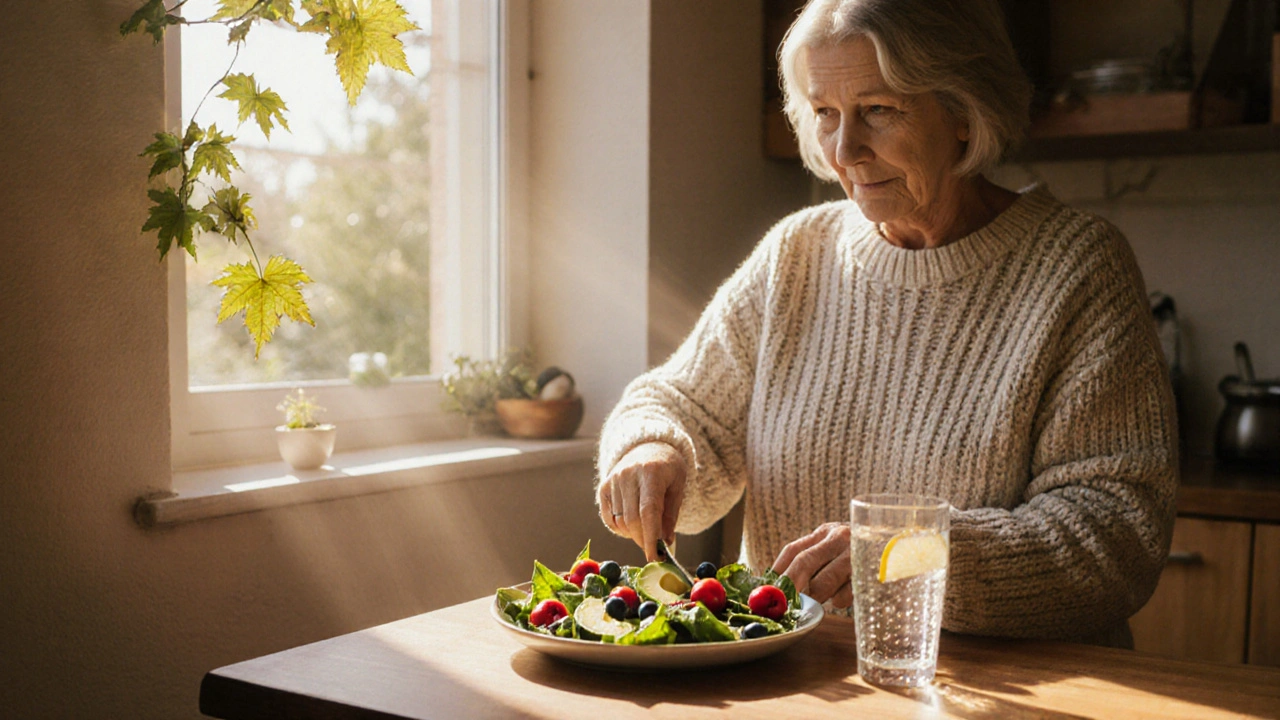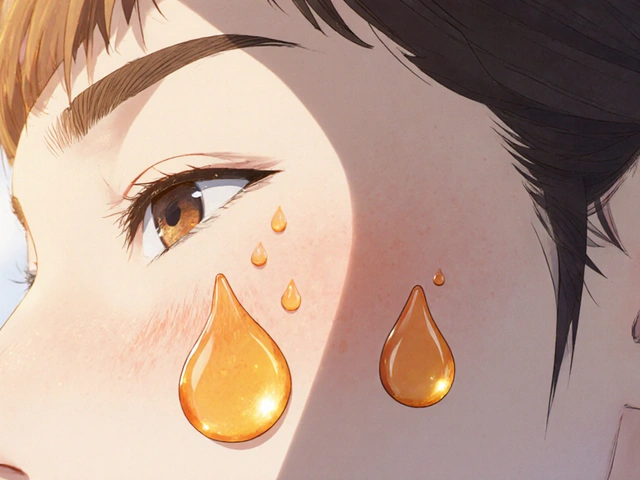
Gout Flare-Up Risk Calculator
Assess your risk of a gout flare-up based on your daily habits and food choices.
Living with Gouty Arthritis is a daily balancing act between flare‑ups and trying to keep your joints moving. The good news? Small, consistent changes can dramatically cut the risk of irreversible joint damage. Below you’ll find a step‑by‑step guide that tackles the chemistry, the lifestyle tweaks, and the medical options that keep your joints safe.
Quick Takeaways
- Control blood Uric Acid levels through diet, hydration, and medication.
- Choose low‑impact exercises that strengthen muscles without stressing joints.
- Limit alcohol and high‑purine foods that trigger crystal formation.
- Use NSAIDs, colchicine, or urate‑lowering therapy under doctor supervision.
- Monitor joint changes and seek early medical advice to avoid permanent damage.
Understanding Gouty Arthritis
At its core, Gouty Arthritis is an inflammatory condition caused by the buildup of Uric Acid in the blood. When levels rise above the solubility threshold-about 6.8 mg/dL-crystals of Monosodium Urate Crystals precipitate in joints, especially the big toe, ankle, and knee.
These needle‑shaped crystals ignite a fierce immune response, releasing cytokines that cause the classic burning pain, swelling, and redness. Repeated attacks lead to chronic inflammation, and over time the cartilage erodes, giving way to Joint Damage.
Why Joint Damage Happens and How to Stop It
Each flare‑up leaves tiny scars on cartilage. Think of it like the surface of a road: a few potholes are manageable, but many deepen and spread, eventually making the road unsafe. The same happens inside your joints-cartilage thins, bone spurs form, and range of motion shrinks.
Prevention hinges on three pillars:
- Lower uric‑acid production.
- Boost crystal dissolution and excretion.
- Protect the joint mechanically with muscle support and smart movement.
When you attack all three, you dramatically cut the chance of permanent damage.
Lifestyle & Diet Strategies That Work
Diet is the most controllable factor. Here’s a practical checklist:
- Hydrate like a champ. Aim for at least 2.5‑3L of water daily. Water dilutes uric acid and helps kidneys flush it out.
- Trim purine‑rich foods. Limit red meat, organ meats (liver, kidney), anchovies, sardines, and shellfish. A serving of lean poultry (≈100g) is usually safe.
- Go dairy‑heavy. Low‑fat milk and yogurt have been shown to lower uric‑acid levels by 5‑10%.
- Embrace cherries. 1‑2 cups of fresh or frozen tart cherries daily can cut flare‑up risk by up to 35% (clinical trial, 2023).
- Limit alcohol. Beer and spirits spike uric acid more than wine. Keep alcohol to <2units per week, or avoid entirely during an attack.
- Watch sugary drinks. Fructose‑laden sodas increase uric production. Swap with sparkling water infused with citrus.
Weight loss, even 5‑10% of body weight, improves insulin sensitivity and reduces uric‑acid reabsorption in the kidneys. Pair diet changes with regular, low‑impact cardio (walking, cycling) for the best results.

Safe Exercises for Joint Protection
Exercise isn’t just okay-it’s essential. Strong muscles act as shock absorbers for joints. Choose activities that avoid excessive joint compression:
- Walking. 30minutes at a brisk pace strengthens calf and quadriceps muscles without overloading the knee.
- Swimming or water‑based aerobics. The buoyancy reduces impact forces while still providing resistance.
- Stationary cycling. Low‑impact cardio that keeps the knee moving through a safe range of motion.
- Resistance bands. Gentle strengthening of hip abductors, hamstrings, and forearm flexors helps stabilize the toe and ankle during daily tasks.
- Yoga (joint‑friendly poses). Cat‑cow, bridge, and seated twists improve flexibility without deep knee bends.
Avoid high‑impact sports like running or basketball during active gout phases. If you feel a twinge, pause and apply the RICE method (Rest, Ice, Compression, Elevation) before resuming.
Medication Overview
When lifestyle tweaks aren’t enough, medication backs you up. The goal is twofold: stop acute inflammation and keep uric‑acid levels under control long term.
| Medication | Primary Use | Typical Dose | Key Side Effects |
|---|---|---|---|
| NSAIDs | Acute pain & inflammation | Ibuprofen 400‑800mg q6‑8h | Stomach upset, kidney strain |
| Colchicine | Acute attacks (early) | 1.2mg then 0.6mg 1h later | Diarrhea, nausea |
| Allopurinol | Long‑term urate‑lowering | 100‑300mg daily | Rash, rare severe hypersensitivity |
| Febuxostat | Urate‑lowering for allopurinol‑intolerant | 40‑80mg daily | Cardiovascular warning, liver enzymes |
Start urate‑lowering therapy only after the acute flare subsides-jump‑starting meds during a flare can worsen pain. Regular blood tests every 2‑3 months track uric‑acid response and catch side effects early.
Daily Habits to Reduce Flare‑Ups
- Keep a uric‑acid log. Note foods, drinks, and any symptoms. Patterns emerge quickly.
- Elevate feet during long periods of standing. Reduces ankle pressure that can trigger crystal deposition.
- Wear supportive shoes. Cushioned insoles and a proper toe box avoid compression of the metatarsophalangeal joint.
- Apply ice promptly. 15‑20minutes at the first sign of swelling accelerates crystal dissolution.
- Stay on schedule. Never skip a dose of allopurinol or febuxostat-even on “good” days.
When to Seek Medical Help
If you notice any of the following, call your GP or rheumatologist right away:
- Severe swelling that doesn’t improve after 48hours of home care.
- Fever >38°C accompanying joint pain.
- Sudden loss of joint function or inability to bear weight.
- Kidney stones or unexplained changes in urine color.
Early intervention can prevent tophi formation-a hard deposit of urate crystals that permanently deforms joints. The sooner you act, the easier it is to preserve joint integrity.
Frequently Asked Questions
Can I eat meat if I have gout?
Yes, but in moderation. Choose lean cuts, limit portion size to 100g, and balance with low‑purine vegetables and dairy. Frequent consumption of red or organ meat can raise uric‑acid levels and trigger attacks.
Is alcohol always bad for gout?
Beer and spirits are the worst because they contain both alcohol and purines. A small amount of dry wine may be tolerable for some, but keep intake under two drinks per week and monitor how your body reacts.
How fast does allopurinol work?
Allopurinol gradually lowers serum uric acid over weeks. It usually takes 4‑6weeks to see a meaningful drop, and a full 3‑month period to reach a stable target below 6mg/dL.
Are there natural supplements that help?
Vitamin C (500mg daily) can modestly reduce uric‑acid levels, and fish oil may ease inflammation. However, supplements should never replace prescribed meds; discuss any additions with your doctor.
What should I do during a sudden gout flare?
Rest the affected joint, apply ice for 15‑20minutes, stay hydrated, and take an NSAID or colchicine as directed. If pain remains severe after 24hours, contact your healthcare provider for possible steroid injection.
Write a comment
Your email address will not be published.






5 Comments
If you keep munching steaks and sipping beer, don’t be shocked when your joints scream.
That calculator looks handy you can actually see how small changes add up. Reducing booze by a couple drinks a week and adding a glass of water can shift you from high to moderate risk. It’s a simple tweak that saves a lot of pain.
Gout, often misunderstood as merely a consequence of overindulgence, is in fact a complex metabolic disorder rooted in uric acid dysregulation. When purine‑rich foods such as organ meats, certain seafood, and excessive alcohol enter the bloodstream, the liver metabolises them into uric acid, which may precipitate as monosodium urate crystals in joints. These crystals trigger an intense inflammatory cascade mediated by neutrophils, leading to the characteristic excruciating pain. Preventative strategies, therefore, must address both dietary intake and renal excretion efficiency. Hydration emerges as a cornerstone; sufficient water intake dilutes serum urate concentration and facilitates renal clearance. The interactive risk calculator embedded in the article cleverly quantifies habit‑related contributions, allowing users to visualise the incremental impact of each factor. For instance, reducing weekly alcohol consumption from eight to three drinks lowers the risk score by three points, often shifting a patient from a high‑risk to a moderate‑risk profile. Equally important is the moderation of red meat and shellfish, which are dense sources of purines; substituting plant‑based proteins can further attenuate urate production. Moreover, lifestyle adjustments such as regular physical activity improve insulin sensitivity, which indirectly benefits uric acid metabolism. While pharmacologic agents like allopurinol remain essential for many patients, non‑pharmacologic measures provide a sustainable foundation and can reduce the required dosage of medication. It is also prudent to monitor serum urate levels periodically, aiming for a target below 6 mg/dL to minimise crystal formation. Education about symptom recognition enables earlier intervention during flare‑ups, where anti‑inflammatory agents can be administered promptly. In sum, joint protection in gout demands a holistic approach: disciplined nutrition, optimal hydration, regular exercise, and vigilant monitoring. By integrating these practices, individuals can preserve joint integrity and diminish the frequency of painful attacks.
Our people have known for centuries that excess booze and greasy meat are the enemy of a strong body. This Western obsession with indulgence is why many of our community members suffer from joint devastation. Cut the alcohol, eat the native greens, and you’ll see the pain melt away. It’s time we stop copying destructive habits and return to our roots.
From the perspective of Ayurvedic principles, the imbalance of Pitta dosha often manifests as uric acid accumulation. Adopting a diet low in tamasic foods, coupled with regular ingestion of herbal diuretics such as punarnava, can restore equilibrium. Moreover, mindful meditation aids in stress reduction, which indirectly benefits renal function. It is advisable to consult a qualified practitioner to tailor these interventions to the individual constitution.